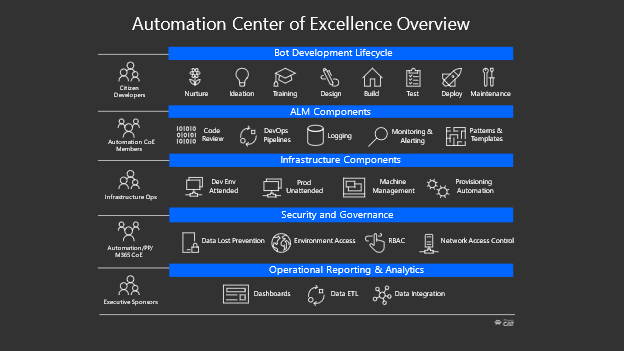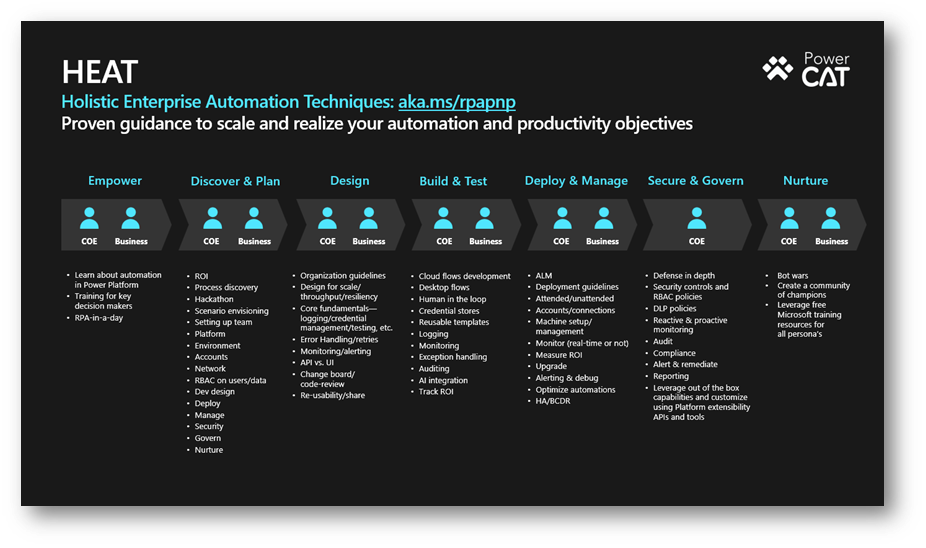Automation Maturity Model: Power Up your RPA and hyper-automation adoption journey!
Microsoft Power Automate helps organizations truly drive their digital journey. Automation is more than just a buzzword today; it is the lifeline of successful organizations. Power Automate helps bridge the technology gap, enabling citizen developers to build robust and secure automation to address their automation needs.
It is our goal to empower everyone to build automated processes with flows in Power Automate. Using low-code, drag-and-drop tools and hundreds of pre-built connectors that automate repetitive, mundane tasks with ease, Power Automate truly empowers business users to build automation. Through lessons learnt and best practices observed from many of our customer engagements we have curated a sequence of patterns across a progressive scale.
Earlier this year, we launched an Automation CoE Blueprint (which contains proven guidance for establishing and scaling an Automation Center of Excellence in your organization). The goal of the Automation Maturity Model is to help organizations and their partners to think through how they can improve their current capabilities and align them to business outcomes.
A successful automation implementation requires technology, process and people to be aligned. The Automation Maturity Model is inspired by HEAT – Holistic Enterprise Automation Techniques and the Capability Maturity Model
Get your copy of the Automation Maturity Model Today!
Level 100 – Initial
Failing forward, experimentation, feasibility analysis, cautious optimism
In the “Initial” phase, the organization has just begun its journey with Power Automate – tool capabilities, its alignment and integration with the Enterprise Architecture/Automation vision is evaluated. Technology and Business vertical representatives, discuss overarching technology and business goals encompassing organization specific Enterprise Networking, Information Security, Legal and Privacy requirements. Organization charters technology upskilling endeavors to enable Power Automate adoption across the enterprise. Key Performance Indicators measuring automation benefits and its subsequent influence on the operational metrics across the enterprise is established (albeit the process of recording progress is still manual at this phase).
Level 200 – Repeatable
Enterprise “on-board,” digital stewardship, bias to action
In the “Repeatable” phase, the enterprise evolves in its automation journey by “codifying” lessons learned from the “Initial” phase. An automation Center of Excellence (CoE) is established to evangelize automation adoption and serve as a liaison between technology and business stakeholders. The CoE also defines best practices on automation, including – process selection, infrastructure setup/maintenance, security management, application life cycle management, and license management. The enterprise understands the value proposition automation offers, promotes Power Automate training across the board and drives change management initiatives. Based on the experiences from the prior phase, teams highlight potential automation opportunities.
Level 300 – Defined
Iterative standardization, feedback elicitation, gaps fulfillment, business/technology resilience
In the “Defined” phase, the enterprise continues to standardize and refine processes established in the “Repeatable” phase. Organizations may choose to redefine goals based on lessons learnt and progress made in prior phases, whilst striving towards continuous improvement. The groundwork established in the prior phases are further evolved with a bias towards scale, security and resilience. Therefore, the CoE drives initiatives to automate governance and platform related concerns to promote scale. Platform governance related initiatives, encompassing environment provisioning, Data Loss Prevention (DLP) policy requests, licensing and machine management are implemented in this phase.
Security posture of the organization is enriched by addressing network security concerns including firewall setup, Intrusion Detection System (IDS), Intrusion Prevention System (IPS) and industry specific network security protocol standards. Concerning findings (potential policy violations, exploits and vulnerabilities) should be readily addressed. The enterprise’s maturity to address network concerns should be gauged periodically. As the practice matures, Power Automate emerges to be an integral part of the technology landscape of the organization. Hence, the need to build fault tolerant processes is inevitable. As a result, the Automation CoE formalizes internal guard rails by defining disaster recovery scenarios including – business impact analysis, risk analysis, network/cloud/data recovery with a definitive business continuity plan in the event of a failure.
Level 400 – Capable
Strategic benchmarking, technology driven optimization, “business led, CoE supported”
In this phase, the enterprise has established processes for monitoring and managing automation health from both a quantitative and qualitative perspective. The enterprise is successful in democratizing automation across both business and technical verticals. Automation initiatives shift from a CoE driven to a citizen developer driven model. The enterprise builds on their technology capabilities enriching their automation landscape. Process mining tools are leveraged to optimize processes and improve process efficiency. Pro developers collaborate to build the necessary APIs (Application Programming Interfaces) to facilitate citizen developers to build automation. AI (Artificial Intelligence) based capabilities are implemented to solve business problems in the context of process automation. Enterprises can attend to a wider array of use cases as a result of fusion of technologies.
Level 500 – Efficient
Community beacons, cross team collaboration, addressing gaps hindering excellence
In the efficient phase, the enterprise is at a mature state in its automation journey from a business process, technology enablement and automation adoption perspective. In the context of automation, the enterprise has established its capabilities to harmoniously integrate Power Automate to its digital landscape. Governance, security management, KPI dashboarding, application lifecycle management procedures are thoroughly automated with minimal to no manual effort required to sustain these processes.
A well-established community of experts help resolve any issues and queries citizen developers may have in building automation. Fusion teams involving experts from cloud, AI and other modern technological capabilities collaborate to build elegant automation processes leveraging the benefits a mélange of these technologies can offer. Organizations at the Efficient phase have executive sponsorship play a pivotal role in the digitization of the enterprise. “Efficient” enterprises serve as beacons for other organizations looking to progress in their automation maturity by sharing best practices and helping organizations overcome the challenges they may face.
Here is a high-level snapshot of The Automation Maturity Model, which captures goals, realization and required resources across the various phases of maturity.
Start rolling out an automation program today with these resources!
- Automation CoE Blueprint https://aka.ms/autocoeblueprint
- Automation CoE Strategy https://aka.ms/autocoestrategy
- HEAT https://aka.ms/rpapnp
- HEAT video series https://aka.ms/rpapnpvideo
- Admin & Governance Whitepaper https://aka.ms/autocoeadminwhitepaper
- Manage Power Automate for Desktop on Windows https://aka.ms/padonwindowspnp
- Hyper-automation SAP playbook (https://aka.ms/MicrosoftRPAPlaybookForSAPGUI) & video series (https://aka.ms/AutomateItSAPSeries)
- Customer Stories
- Coca-Cola: https://aka.ms/cocacolaautomationplatform
- Coca-Cola United: https://aka.ms/cocacolaunitedrpa
- TC Energy Bot Wars: https://aka.ms/Bot-Wars
- Inter Pipeline Botwars: https://youtu.be/bzN3CkOt_go?t=1773
- Chemours: https://www.youtube.com/watch?v=ZnSsixwJDQ0
- Customer stories: https://aka.ms/powerautomatestories
- Learn
- Automate It: https://aka.ms/AutomateIt
- Holistic Enterprise Automation Techniques (HEAT): https://aka.ms/rpapnp
- RPA in a Day Training: https://aka.ms/RPAinaDayPackage
- Power Automate Learn Browse all – Learn | Microsoft Docs



